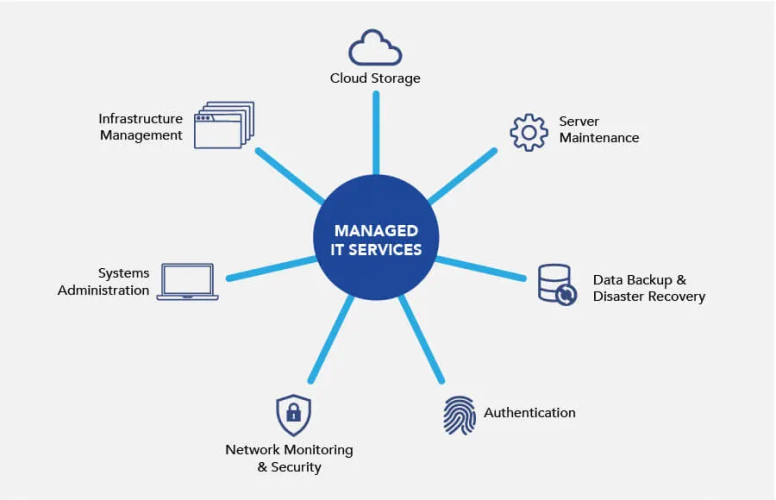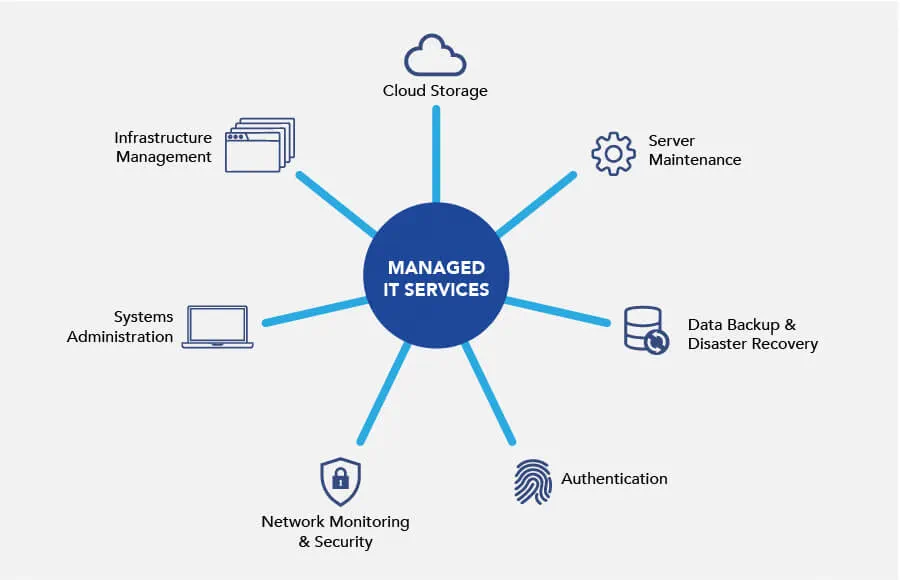
How Do Managed IT Services Work?
How do managed IT services work? Well, picture this: you're at home, playing your favorite online game, when suddenly your internet connection starts acting up. Frustrating, right? That's where managed IT services come in. They're like the superheroes of the digital world, working behind the scenes to keep everything running smoothly.
So, what exactly are managed IT services? They're a team of experts who take care of all your IT needs, from setting up and maintaining your computer systems to protecting your data from cyberattacks. They handle everything so you can focus on what you do best.
But how do they do it? Managed IT services work by proactively monitoring your systems, detecting and fixing issues before they become major problems. They also provide regular updates, ensure your software is up to date, and offer round-the-clock support, so you're never left stranded.
In a nutshell, managed IT services are like having your personal IT department. They keep your technology running smoothly, so you can enjoy uninterrupted online gaming or whatever else you love doing. It's like having a team of tech-savvy superheroes who have your back when it comes to all things digital. Pretty cool, right? So, let's dive in and find out more about how managed IT services work!

How Do Managed IT Services Work?
Managed IT services have become increasingly popular in the digital age as businesses seek to optimize their technology infrastructure and ensure smooth operations. But how exactly do managed IT services work? In this article, we will delve into the details of managed IT services, exploring their core concepts, benefits, and the key tasks they perform. Whether you are a business owner or just curious about the world of IT support, this article will provide you with a comprehensive understanding of how managed IT services work.
The Role of Managed IT Services
Managed IT services play a vital role in supporting businesses by handling their IT systems and infrastructure. They bridge the gap between internal IT capabilities and the need for specialized expertise, providing a proactive and strategic approach to technology management. With managed IT services, businesses can offload the burden of day-to-day IT operations, allowing them to focus on their core competencies.
1. Assessing IT Needs and Infrastructure
The first step in the process of managed IT services is to conduct a thorough assessment of the client's IT needs and infrastructure. This involves in-depth analysis of the existing technology systems, identifying potential areas for improvement, and understanding the specific requirements of the client's business. By gaining a comprehensive understanding of the IT landscape, managed service providers can develop tailored solutions that align with the client's goals.
During the assessment phase, the managed service provider will evaluate factors such as network infrastructure, hardware and software resources, security measures, and disaster recovery plans. This information serves as a foundation for creating a robust IT strategy that maximizes efficiency, minimizes downtime, and enhances overall performance.
Additionally, the assessment process helps identify any potential risks or vulnerabilities in the client's IT infrastructure, allowing proactive measures to be taken to mitigate these issues before they become major problems. This proactive approach is a key differentiator of managed IT services, as it shifts the focus from reactive troubleshooting to preventative maintenance and continuous improvement.
2. Designing and Implementing IT Solutions
Once the assessment phase is complete, the managed service provider will collaborate with the client to design and implement customized IT solutions. This involves carefully selecting the appropriate technology components, software applications, and security measures to address the specific needs of the business.
The design and implementation process includes tasks such as configuring network systems, installing necessary hardware and software, setting up cybersecurity protocols, and integrating different IT components to ensure seamless operations. The managed service provider will work closely with the client's internal IT team to ensure a smooth transition and minimal disruption during the implementation phase.
Throughout the design and implementation process, managed service providers follow industry best practices and adhere to strict security standards to safeguard the client's data and ensure compliance with relevant regulations. They also provide ongoing support and guidance to help the client navigate any potential challenges that may arise during the transition period.
3. Monitoring and Maintenance
After the IT solutions are implemented, managed service providers take on the responsibility of monitoring and maintaining the client's IT infrastructure on an ongoing basis. This includes proactive monitoring of network performance, identifying and addressing potential issues before they cause disruptions, and ensuring optimal system uptime.
Managed service providers utilize advanced monitoring tools and technologies to monitor the client's systems, servers, applications, and devices in real-time. This enables them to detect any anomalies, potential security breaches, or performance bottlenecks early on, allowing for prompt resolution and minimizing any negative impact on the client's business operations.
Regular maintenance tasks, such as software updates, security patches, and system backups, are also performed by managed service providers to keep the client's IT infrastructure up-to-date and secure. They also provide proactive support and troubleshooting services to address any IT-related issues that may arise, ensuring the client's business remains productive and efficient.
Key Takeaways: How do managed IT services work?
- Managed IT services are a type of outsourcing where a company hires a third-party provider to handle their IT needs.
- The provider takes care of tasks such as network monitoring, software updates, data backups, and cybersecurity.
- Managed IT services allow businesses to focus on their core operations while leaving the technical aspects to the experts.
- These services offer proactive maintenance and support, helping to prevent IT issues before they become major problems.
- By hiring managed IT services, companies can save costs on hiring and training their own IT staff.
Frequently Asked Questions
Welcome to our frequently asked questions about how managed IT services work. Discover everything you need to know about this topic and gain a better understanding of how managed IT services can benefit your business.
1. How can managed IT services help improve my business?
Managed IT services can greatly benefit your business by providing expert assistance in all areas of technology. By outsourcing your IT needs to a managed service provider (MSP), you gain access to a team of professionals who can monitor and maintain your network infrastructure, handle cybersecurity threats, provide software and hardware support, and offer proactive solutions to keep your business running smoothly. This allows you to focus on your core business objectives, increase productivity, and reduce downtime.
Additionally, managed IT services can help you stay up to date with the latest technology trends, ensuring that your systems are always running efficiently and securely. With the expertise and support of an MSP, your business can achieve a higher level of performance and competitiveness in the market.
2. How does the monitoring and maintenance aspect of managed IT services work?
Monitoring and maintenance are essential components of managed IT services. A managed service provider will use advanced monitoring tools to keep a close eye on your network, servers, and devices in real-time. This proactive approach allows them to identify any issues or potential problems before they impact your business operations.
The provider will perform regular maintenance tasks such as applying software updates, installing security patches, and optimizing system performance. By continuously monitoring and maintaining your IT infrastructure, they can prevent downtime, minimize disruptions, and ensure that your systems are running smoothly and securely around the clock.
3. How do managed IT services handle cybersecurity threats?
Managed IT services play a crucial role in protecting your business from cybersecurity threats. The provider will implement a multi-layered security approach that includes firewalls, antivirus software, intrusion detection systems, and regular security assessments. They will also establish strong security policies and protocols to ensure that your data and systems are protected.
In the event of a cyber attack or breach, the managed service provider will have incident response plans in place to quickly mitigate the damage and minimize the impact on your business. They will also provide ongoing employee training to educate your staff about best security practices and raise awareness about potential threats.
4. Can managed IT services assist with software and hardware support?
Absolutely! Managed IT services encompass comprehensive software and hardware support. Whether you are facing software glitches, hardware failures, or compatibility issues, your managed service provider will be there to assist you. They will have a dedicated team of experts who can troubleshoot and resolve technical problems promptly.
If you need to upgrade or replace your hardware, the managed service provider can guide you through the process, recommending suitable options based on your specific requirements and budget. They will also ensure that your software is properly licensed and up to date, protecting you from potential compliance issues.
5. How can managed IT services improve my business's productivity and efficiency?
Managed IT services can significantly enhance your business's productivity and efficiency by streamlining your technology infrastructure. The provider will optimize your network, servers, and devices to ensure optimal performance, reducing any bottlenecks or slowdowns.
By implementing proactive maintenance and monitoring, they can prevent unexpected downtime and minimize disruptions. In addition, the managed service provider can suggest and implement technological solutions that can automate manual processes, streamline workflows, and enhance collaboration among your employees. With a reliable and efficient IT infrastructure in place, your business can operate more smoothly and efficiently, leading to increased productivity and profitability.
Managed Services Solutions | What is Managed IT Services?
Summary
Managed IT services are like having a team of computer experts to help with your tech needs. They can support your devices, fix problems, and keep everything running smoothly. With managed IT services, you can focus on your work while someone else takes care of your technology.
In a nutshell, managed IT services work by providing ongoing support and maintenance for your computers and devices. Instead of dealing with tech issues on your own, you have a team of experts available to help. It's like having a personal IT department to keep your technology working properly and make your life easier.
Recent Posts
- How Does GPON Improve Network Efficiency?
- What Are The Advantages Of GPON?
- What Are The Benefits Of IT Outsourcing?
- What's The Deal With Ransomware Attacks?
- Are GPON Providers Widely Available?
- What's GPON's Impact On Bandwidth?
- Why Is Multi-Factor Authentication Important?
- How To Ensure Data Privacy Compliance?
 Blogs
Blogs Infographics
Infographics Videos
Videos Podcasts
Podcasts Case Studies
Case Studies Call For Quote
Call For Quote